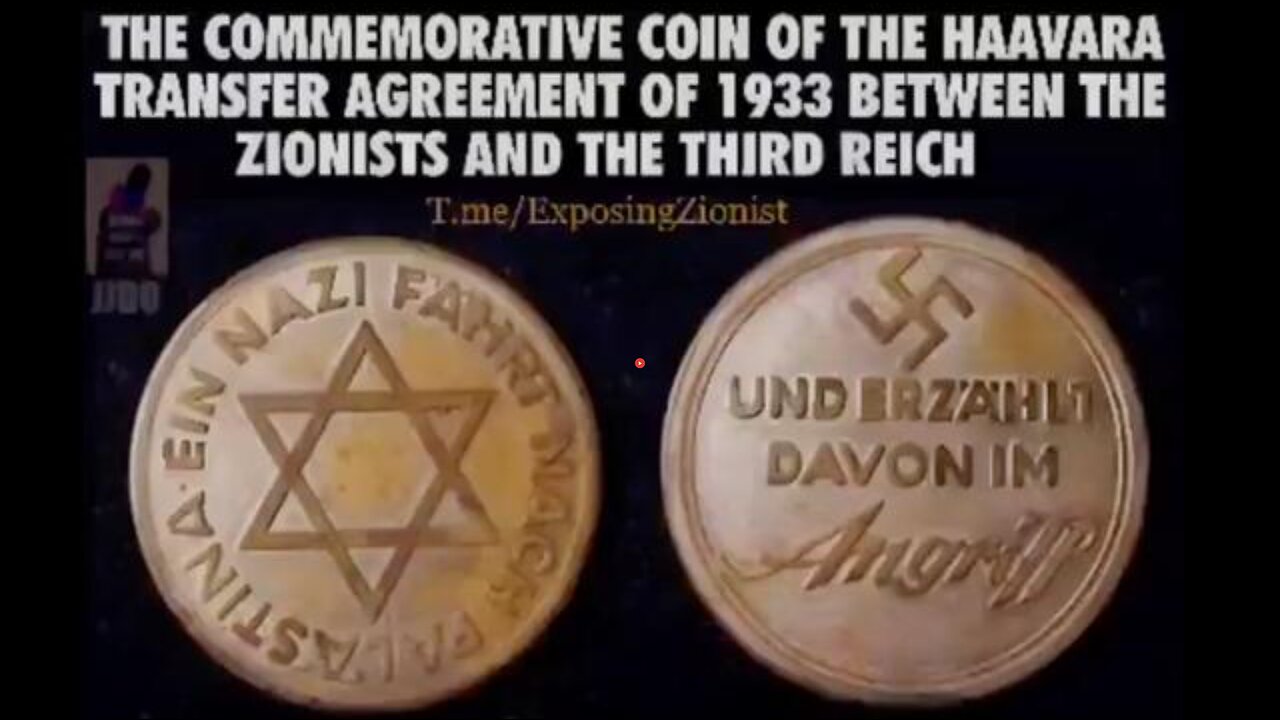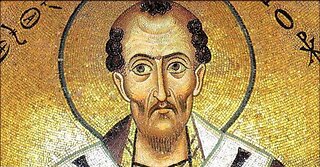Premium Only Content

ZIONISM AND NAZISM - TWO SIDES OF THE SAME COIN!
National Socialism most often refers to Nazism, the ideology of the Nazi Party, which ruled Nazi Germany from 1933 to 1945. The term "national socialism" was used by a number of unrelated groups before the Nazis, but since their rise to prominence it has become associated almost exclusively with their ideas.
The Haavara Agreement (Hebrew: הֶסְכֵּם הַעֲבָרָה Translit.: heskem haavara Translated: "transfer agreement") was an agreement between Nazi Germany and Zionist German Jews signed on 25 August 1933. The agreement was finalized after three months of talks by the Zionist Federation of Germany, the Anglo-Palestine Bank (under the directive of the Jewish Agency) and the economic authorities of Nazi Germany. It was a major factor in making possible the migration of approximately 60,000 German Jews to Palestine between 1933 and 1939.[1]
The agreement enabled Jews fleeing persecution under the new Nazi regime to transfer some portion of their assets to British Mandatory Palestine.[2] Emigrants sold their assets in Germany to pay for essential goods (manufactured in Germany) to be shipped to Mandatory Palestine.[3][4] The agreement was controversial and was criticised by many Jewish leaders both within the Zionist movement (such as the Revisionist Zionist leader Ze'ev Jabotinsky) and outside it, as well as by members of both the Nazi Party and the German public.[4] For German Jews, the agreement offered a way to leave an increasingly hostile environment in Germany; for the Yishuv, the Jewish community in Palestine, it offered access to both immigrant labour and economic support; for the Germans it facilitated the emigration of German Jews while breaking the anti-Nazi boycott of 1933, which had mass support among European and American Jews and was thought by the German state to be a potential threat to the German economy.[4][5]
Background
Although the Nazi Party won the greatest share of the popular vote in the two Reichstag general elections of 1932, they did not have a majority, so Hitler led a short-lived coalition government formed by the Nazis and the German National People's Party.[6] Under pressure from politicians, industrialists and others, President Paul von Hindenburg appointed Hitler as Chancellor of Germany on 30 January 1933. This event is known as the Machtergreifung (seizure of power).[7] In the following months, the Nazis used a process termed Gleichschaltung (co-ordination) to consolidate power.[8] By June 1933, virtually the only organisations not under the control of the Nazi party were the army and the churches.[9]
Within the Nazi movement, a variety of (increasingly radical) "solutions" to the "Jewish Question" were proposed both before and after the Nazi party was in government, including expulsion and the encouragement of voluntary emigration. Widespread civil persecution of German Jews began as soon as the Nazis were in power.[10] For example, on 1 April, the Nazis organized a nationwide boycott of Jewish-owned businesses in Germany; under the Law for the Restoration of the Professional Civil Service which was implemented on 7 April, Jews were excluded from the civil service; on 25 April, quotas were imposed on the number of Jews in schools and universities. Jews outside Germany responded to these persecutions with a boycott of German goods.
Meanwhile, in Mandatory Palestine, a growing Jewish population (174,610 in 1931, rising to 384,078 in 1936[11]) was acquiring land and developing the structures of a future Jewish state despite opposition from the Arab population.
Hanotea company
Transfer agreement used by the Palästina Treuhandstelle (Palestine Trustee Office[12]), established specifically to assist Jews fleeing the Nazi regime to recover some portion of the assets they had been forced to surrender when they fled Nazi Germany
Hanotea (הַנּוֹטֵעַ, "the Planter") was a citrus planting company based in Netanya and established in 1929 by long-established Jewish settlers in Palestine involved in the Benei Binyamin movement.[13] In a deal worked out with the Reich Economics Ministry, the blocked German bank accounts of prospective immigrants would be unblocked and funds from them used by Hanotea to buy agricultural German goods; these goods, along with the immigrants, would then be shipped to Palestine, and the immigrants would be granted a house or citrus plantation by the company to the same value.[14] Hanotea's director, Sam Cohen, represented the company in direct negotiation with the Reich Economics Ministry beginning in March 1933.[15] In May 1933 Hanotea applied for permission to transfer capital from Germany to Palestine.[15] This pilot arrangement appeared to be operating successfully,[citation needed] and so paved the way for the later Haavara Agreement.
The transfer agreement
CERTIFICATE
The Trust and Transfer Office "Haavara" Ltd. places at the disposal of the Banks in Palestine amounts in Reichmarks which have been put at its disposal by the Jewish immigrants from Germany. The Banks avail themselves of these amounts in Reichmarks in order to make payments on behalf of Palestinian merchants for goods imported by them from Germany. The merchants pay in the value of the goods to the Banks and the "Haavara" Ltd. pays the countervalue to the Jewish immigrants from Germany. To the same extent that local merchants will make use of this arrangement, the import of German goods will serve to withdraw Jewish capital from Germany.
The Trust and Transfer Office,
HAAVARA, LTD.
— Example of the certificate issued by Haavara to Jews emigrating to Palestine
The Haavara (Transfer) Agreement, negotiated by Eliezer Hoofein, director of the Anglo-Palestine Bank,[16] was agreed to by the Reich Economics Ministry in 1933, and continued, with declining German government support,[17] until it was wound up in 1939.[18] Under the agreement, Jews emigrating from Germany could use their assets to purchase German-manufactured goods for export, thus salvaging their personal assets during emigration. The agreement provided a substantial export market for German factories in British-ruled Palestine. Between November 1933, and 31 December 1937, 77,800,000 Reichmarks, or $22,500,000, (values in 1938 currency) worth of goods were exported to Jewish businesses in Palestine under the program.[17] By the time the program ended with the start of World War II, the total had risen to 105,000,000 marks (about $35,000,000, 1939 values).[18]
Emigrants with capital of £1,000, (about $5,000 in 1930s currency value) could move to Palestine in spite of severe British restrictions on Jewish immigration under an immigrant investor program similar to the modern United States EB-5 visa. Under the Transfer Agreement, about 39% of an emigrant's funds were given to Jewish communal economic development projects, leaving individuals with about 43% of the funds.[19][20]
The Haavara Agreement was thought by some German circles to be a possible way to solve the "Jewish problem." The head of the Middle Eastern division of the foreign ministry, the anti-Nazi politician Werner Otto von Hentig, supported the policy of settling Jews in Palestine. Hentig believed that if the Jewish population was concentrated in a single foreign entity, then foreign diplomatic policy and containment of the Jews would become easier.[21] Hitler's own support of the Haavara Agreement was unclear and varied throughout the 1930s. Initially, Hitler seemed indifferent to the economic details of the plan, but he supported it in the period from September 1937 to 1939.[22]
After the German invasion of Poland in September 1939 the program was ended.[18]
Responses
The agreement was controversial both within the Nazi party and in the Zionist movement.[23] As historian Edwin Black put it, "The Transfer Agreement tore the Jewish world apart, turning leader against leader, threatening rebellion and even assassination."[24] Opposition came from the mainstream US leadership of the World Zionist Congress, in particular Abba Hillel Silver and American Jewish Congress president Rabbi Stephen Wise.[25] Wise and other leaders of the Anti-Nazi boycott of 1933 argued against the agreement, narrowly failing to persuade the Nineteenth Zionist Congress in August 1935 to vote against it.[24]
The right-wing Revisionist Zionists and their leader Vladimir Jabotinsky were even more vocal in their opposition.[26] The Revisionist newspaper in Palestine, Hazit Haam published a sharp denunciation of those involved in the agreement as "betrayers", and shortly afterwards one of the negotiators, Haim Arlosoroff was assassinated.[24]
Nazism (/ˈnɑːtsɪzəm, ˈnæt-/ NA(H)T-siz-əm; also Naziism /-si.ɪzəm/),[1] the common name in English for National Socialism (German: Nationalsozialismus, German: [natsi̯oˈnaːlzotsi̯aˌlɪsmʊs] ⓘ), is the far-right totalitarian political ideology and practices associated with Adolf Hitler and the Nazi Party (NSDAP) in Nazi Germany.[2][3][4] During Hitler's rise to power in 1930s Europe, it was frequently referred to as Hitlerism (German: Hitlerfaschismus). The later related term "neo-Nazism" is applied to other far-right groups with similar ideas which formed after the Second World War.
Nazism is a form of fascism,[5][6][7][8] with disdain for liberal democracy and the parliamentary system. It incorporates a dictatorship,[4] fervent antisemitism, anti-communism, anti-Slavism,[9] scientific racism, white supremacy, Nordicism, social Darwinism and the use of eugenics into its creed. Its extreme nationalism originated in pan-Germanism and the ethno-nationalist Völkisch movement which had been a prominent aspect of German ultranationalism since the late 19th century. Nazism was strongly influenced by the Freikorps paramilitary groups that emerged after Germany's defeat in World War I, from which came the party's underlying "cult of violence".[10] It subscribed to pseudo-scientific theories of a racial hierarchy,[11] identifying ethnic Germans as part of what the Nazis regarded as an Aryan or Nordic master race.[12] Nazism sought to overcome social divisions and create a homogeneous German society based on racial purity which represented a people's community (Volksgemeinschaft). The Nazis aimed to unite all Germans living in historically German territory, as well as gain additional lands for German expansion under the doctrine of Lebensraum and exclude those whom they deemed either Community Aliens or "inferior" races (Untermenschen).
The term "National Socialism" arose out of attempts to create a nationalist redefinition of socialism, as an alternative to both Marxist international socialism and free-market capitalism. Nazism rejected the Marxist concepts of class conflict and universal equality, opposed cosmopolitan internationalism, and sought to convince all parts of the new German society to subordinate their personal interests to the "common good", accepting political interests as the main priority of economic organisation,[13] which tended to match the general outlook of collectivism or communitarianism rather than economic socialism. The Nazi Party's precursor, the pan-German nationalist and antisemitic German Workers' Party (DAP), was founded on 5 January 1919. By the early 1920s, the party was renamed the National Socialist German Workers' Party in order to appeal to left-wing workers,[14] a renaming that Hitler initially objected to.[15] The National Socialist Program, or "25 Points", was adopted in 1920 and called for a united Greater Germany that would deny citizenship to Jews or those of Jewish descent, while also supporting land reform and the nationalisation of some industries. In Mein Kampf ("My Struggle"), published in 1925–1926, Hitler outlined the antisemitism and anti-communism at the heart of his political philosophy as well as his disdain for representative democracy, over which he proposed the Führerprinzip (leader principle), and his belief in Germany's right to territorial expansion through lebensraum.[16]
The Nazi Party won the greatest share of the popular vote in the two Reichstag general elections of 1932, making them the largest party in the legislature by far, albeit still short of an outright majority (37.3% on 31 July 1932 and 33.1% on 6 November 1932). Because none of the parties were willing or able to put together a coalition government, Hitler was appointed Chancellor of Germany on 30 January 1933 by President Paul von Hindenburg through the support and connivance of traditional conservative nationalists who believed that they could control him and his party. With the use of emergency presidential decrees by Hindenburg and a change in the Weimar Constitution which allowed the Cabinet to rule by direct decree, bypassing both Hindenburg and the Reichstag, the Nazis soon established a one-party state and began the Gleichschaltung.
The Sturmabteilung (SA) and the Schutzstaffel (SS) functioned as the paramilitary organisations of the Nazi Party. Using the SS for the task, Hitler purged the party's more socially and economically radical factions in the mid-1934 Night of the Long Knives, including the leadership of the SA. After the death of President Hindenburg on 2 August 1934, political power was concentrated in Hitler's hands and he became Germany's head of state as well as the head of the government, with the title of Führer und Reichskanzler, meaning "leader and Chancellor of Germany" (see also here). From that point, Hitler was effectively the dictator of Nazi Germany – also known as the Third Reich – under which Jews, political opponents and other "undesirable" elements were marginalised, imprisoned or murdered. During World War II, many millions of people—including around two-thirds of the Jewish population of Europe—were eventually exterminated in a genocide which became known as the Holocaust. Following Germany's defeat in World War II and the discovery of the full extent of the Holocaust, Nazi ideology became universally disgraced. It is widely regarded as immoral and evil, with only a few fringe racist groups, usually referred to as neo-Nazis, describing themselves as followers of National Socialism.
Etymology
Nazi Party badge emblem
The full name of the party was Nationalsozialistische Deutsche Arbeiterpartei (German for 'National Socialist German Workers' Party') and they officially used the acronym NSDAP. The term "nazi" had been in use, before the rise of the NSDAP, as a colloquial and derogatory word for a backwards farmer or peasant. It characterised an awkward and clumsy person, a yokel. In this sense, the word Nazi was a hypocorism of the German male name Igna(t)z (itself a variation of the name Ignatius)—Igna(t)z being a common name at the time in Bavaria, the area from which the NSDAP emerged.[17][18]
In the 1920s, political opponents of the NSDAP in the German labour movement seized on this. Using the earlier abbreviated term Sozi for Sozialist (German for 'Socialist') as an example,[19] they shortened the NSDAP's name, Nationalsozialistische, to the dismissive "Nazi", in order to associate them with the derogatory use of the aforementioned term.[20][18][21][22][23][24] The first use of the term "Nazi" by the National Socialists occurred in 1926 in a publication by Joseph Goebbels called Der Nazi-Sozi ["The Nazi-Sozi"]. In Goebbels' pamphlet, the word "Nazi" only appears when linked with the word "Sozi" as an abbreviation of "National Socialism".[25]
After the NSDAP's rise to power in the 1930s, the use of the term "Nazi" by itself or in terms such as "Nazi Germany", "Nazi regime", and so on was popularised by German exiles outside the country, but not in Germany. From them, the term spread into other languages and it was eventually brought back into Germany after World War II.[21] The NSDAP briefly adopted the designation "Nazi" in an attempt to reappropriate the term, but it soon gave up this effort and generally avoided using the term while it was in power.[21][22] In each case, the authors typically referred to themselves as "National Socialists" and their movement as "National Socialism", but never as "Nazis". A compendium of Hitler's conversations from 1941 through 1944 entitled Hitler's Table Talk does not contain the word "Nazi" either.[26] In speeches by Hermann Göring, he never uses the term "Nazi".[27] Hitler Youth leader Melita Maschmann wrote a book about her experience entitled Account Rendered.[28] She did not refer to herself as a "Nazi", even though she was writing well after World War II. In 1933, 581 members of the National Socialist Party answered interview questions put to them by Professor Theodore Abel from Columbia University. They similarly did not refer to themselves as "Nazis".[29]
Position within the political spectrum
Main article: Left–right political spectrum
Left to right: Adolf Hitler, Hermann Göring, Minister of Propaganda Joseph Goebbels, and Rudolf Hess
Nazis alongside members of the far-right reactionary and monarchist German National People's Party (DNVP) during the brief NSDAP–DNVP alliance in the Harzburg Front from 1931 to 1932
The majority of scholars identify Nazism in both theory and practice as a form of far-right politics.[2] Far-right themes in Nazism include the argument that superior people have a right to dominate other people and purge society of supposed inferior elements.[30] Adolf Hitler and other proponents denied that Nazism was either left-wing or right-wing: instead, they officially portrayed Nazism as a syncretic movement.[31][32] In Mein Kampf, Hitler directly attacked both left-wing and right-wing politics in Germany, saying:
Today our left-wing politicians in particular are constantly insisting that their craven-hearted and obsequious foreign policy necessarily results from the disarmament of Germany, whereas the truth is that this is the policy of traitors ... But the politicians of the Right deserve exactly the same reproach. It was through their miserable cowardice that those ruffians of Jews who came into power in 1918 were able to rob the nation of its arms.[33]
In a speech given in Munich on 12 April 1922, Hitler stated:
There are only two possibilities in Germany; do not imagine that the people will forever go with the middle party, the party of compromises; one day it will turn to those who have most consistently foretold the coming ruin and have sought to dissociate themselves from it. And that party is either the Left: and then God help us! for it will lead us to complete destruction—to Bolshevism, or else it is a party of the Right which at the last, when the people is in utter despair, when it has lost all its spirit and has no longer any faith in anything, is determined for its part ruthlessly to seize the reins of power—that is the beginning of resistance of which I spoke a few minutes ago.[34]
Hitler at times redefined socialism. When George Sylvester Viereck interviewed Hitler in October 1923 and asked him why he referred to his party as 'socialists' he replied:
Socialism is the science of dealing with the common weal. Communism is not Socialism. Marxism is not Socialism. The Marxians have stolen the term and confused its meaning. I shall take Socialism away from the Socialists. Socialism is an ancient Aryan, Germanic institution. Our German ancestors held certain lands in common. They cultivated the idea of the common weal. Marxism has no right to disguise itself as socialism. Socialism, unlike Marxism, does not repudiate private property. Unlike Marxism, it involves no negation of personality, and unlike Marxism, it is patriotic.[35]
In 1929, Hitler gave a speech to a group of Nazi leaders and simplified 'socialism' to mean, "Socialism! That is an unfortunate word altogether... What does socialism really mean? If people have something to eat and their pleasures, then they have their socialism."[36]
When asked in an interview on 27 January 1934 whether he supported the "bourgeois right-wing", Hitler claimed that Nazism was not exclusively for any class and he indicated that it favoured neither the left nor the right, but preserved "pure" elements from both "camps" by stating: "From the camp of bourgeois tradition, it takes national resolve, and from the materialism of the Marxist dogma, living, creative Socialism."[37]
Historians regard the equation of Nazism as "Hitlerism" as too simplistic since the term was used prior to the rise of Hitler and the Nazis. In addition, the different ideologies incorporated into Nazism were already well established in certain parts of German society long before World War I.[38] The Nazis were strongly influenced by the post–World War I far-right in Germany, which held common beliefs such as anti-Marxism, anti-liberalism and antisemitism, along with nationalism, contempt for the Treaty of Versailles and condemnation of the Weimar Republic for signing the armistice in November 1918 which later led it to sign the Treaty of Versailles.[39] A major inspiration for the Nazis were the far-right nationalist Freikorps, paramilitary organisations that engaged in political violence after World War I.[39] Initially, the post–World War I German far-right was dominated by monarchists, but the younger generation, which was associated with völkisch nationalism, was more radical and it did not express any emphasis on the restoration of the German monarchy.[40] This younger generation desired to dismantle the Weimar Republic and create a new radical and strong state based upon a martial ruling ethic that could revive the "Spirit of 1914" which was associated with German national unity (Volksgemeinschaft).[40]
The Nazis, the far-right monarchists, the reactionary German National People's Party (DNVP) and others, such as monarchist officers in the German Army and several prominent industrialists, formed an alliance in opposition to the Weimar Republic on 11 October 1931 in Bad Harzburg, officially known as the "National Front", but commonly referred to as the Harzburg Front.[41] The Nazis stated that the alliance was purely tactical and they continued to have differences with the DNVP. After the elections of July 1932, the alliance broke down when the DNVP lost many of its seats in the Reichstag. The Nazis denounced them as "an insignificant heap of reactionaries".[42] The DNVP responded by denouncing the Nazis for their "socialism", their street violence and the "economic experiments" that would take place if the Nazis ever rose to power.[43] However, amidst an inconclusive political situation in which conservative politicians Franz von Papen and Kurt von Schleicher were unable to form stable governments without the Nazis, Papen proposed to President Hindenburg to appoint Hitler as Chancellor at the head of a government formed primarily of conservatives, with only three Nazi ministers.[44][45] Hindenburg did so, and contrary to the expectations of Papen and the DNVP, Hitler was soon able to establish a Nazi one-party dictatorship.[46]
Kaiser Wilhelm II, who was pressured to abdicate the throne and flee into exile amidst an attempted communist revolution in Germany, initially supported the Nazi Party. His four sons, including Prince Eitel Friedrich and Prince Oskar, became members of the Nazi Party in hopes that in exchange for their support, the Nazis would permit the restoration of the monarchy.[47] Hitler dismissed the possibility of a restored monarchy, calling it "idiotic."[48] Wilhelm grew to distrust Hitler and was appalled at the Kristallnacht of 9–10 November 1938, stating, "For the first time, I am ashamed to be a German."[49] The former German emperor also denounced the Nazis as a "bunch of shirted gangsters" and "a mob … led by a thousand liars or fanatics."[50]
There were factions within the Nazi Party, both conservative and radical.[51] The conservative Nazi Hermann Göring urged Hitler to conciliate with capitalists and reactionaries.[51] Other prominent conservative Nazis included Heinrich Himmler and Reinhard Heydrich.[52] Meanwhile, the radical Nazi Joseph Goebbels opposed capitalism, viewing it as having Jews at its core and he stressed the need for the party to emphasise both a proletarian and a national character. Those views were shared by Otto Strasser, who later left the Nazi Party and formed the Black Front in the belief that Hitler had allegedly betrayed the party's socialist goals by endorsing capitalism.[51]
When the Nazi Party emerged from obscurity to become a major political force after 1929, the conservative faction rapidly gained more influence, as wealthy donors took an interest in the Nazis as a potential bulwark against communism.[53] The Nazi Party had previously been financed almost entirely from membership dues, but after 1929 its leadership began actively seeking donations from German industrialists, and Hitler began holding dozens of fundraising meetings with business leaders.[54] In the midst of the Great Depression, facing the possibility of economic ruin on the one hand and a Communist or Social Democrat government on the other hand, German business increasingly turned to Nazism as offering a way out of the situation, by promising a state-driven economy that would support, rather than attack, existing business interests.[55] By January 1933, the Nazi Party had secured the support of important sectors of German industry, mainly among the steel and coal producers, the insurance business, and the chemical industry.[56]
Large segments of the Nazi Party, particularly among the members of the Sturmabteilung (SA), were committed to the party's official socialist, revolutionary and anti-capitalist positions and expected both a social and an economic revolution when the party gained power in 1933.[57] In the period immediately before the Nazi seizure of power, there were even Social Democrats and Communists who switched sides and became known as "Beefsteak Nazis": brown on the outside and red inside.[58] The leader of the SA, Ernst Röhm, pushed for a "second revolution" (the "first revolution" being the Nazis' seizure of power) that would enact socialist policies. Furthermore, Röhm desired that the SA absorb the much smaller German Army into its ranks under his leadership.[57] Once the Nazis achieved power, Röhm's SA was directed by Hitler to violently suppress the parties of the left, but they also began attacks against individuals deemed to be associated with conservative reaction.[59] Hitler saw Röhm's independent actions as violating and possibly threatening his leadership, as well as jeopardising the regime by alienating the conservative President Paul von Hindenburg and the conservative-oriented German Army.[60] This resulted in Hitler purging Röhm and other radical members of the SA in 1934, in what came to be known as the Night of the Long Knives.[60]
Before he joined the Bavarian Army to fight in World War I, Hitler had lived a bohemian lifestyle as a petty street watercolour artist in Vienna and Munich and he maintained elements of this lifestyle later on, going to bed very late and rising in the afternoon, even after he became Chancellor and then Führer.[61] After the war, his battalion was absorbed by the Bavarian Soviet Republic from 1918 to 1919, where he was elected Deputy Battalion Representative. According to historian Thomas Weber, Hitler attended the funeral of communist Kurt Eisner (a German Jew), wearing a black mourning armband on one arm and a red communist armband on the other,[62] which he took as evidence that Hitler's political beliefs had not yet solidified.[62] In Mein Kampf, Hitler never mentioned any service with the Bavarian Soviet Republic and he stated that he became an antisemite in 1913 during his years in Vienna. This statement has been disputed by the contention that he was not an antisemite at that time,[63] even though it is well established that he read many antisemitic tracts and journals during that time and admired Karl Lueger, the antisemitic mayor of Vienna.[64] Hitler altered his political views in response to the signing of the Treaty of Versailles in June 1919 and it was then that he became an antisemitic, German nationalist.[63]
Hitler expressed opposition to capitalism, regarding it as having Jewish origins and accusing capitalism of holding nations ransom to the interests of a parasitic cosmopolitan rentier class.[65] He also expressed opposition to communism and egalitarian forms of socialism, arguing that inequality and hierarchy are beneficial to the nation.[66] He believed that communism was invented by the Jews to weaken nations by promoting class struggle.[67] After his rise to power, Hitler took a pragmatic position on economics, accepting private property and allowing capitalist private enterprises to exist so long as they adhered to the goals of the Nazi state, but not tolerating enterprises that he saw as being opposed to the national interest.[51]
German business leaders disliked Nazi ideology but came to support Hitler, because they saw the Nazis as a useful ally to promote their interests.[68] Business groups made significant financial contributions to the Nazi Party both before and after the Nazi seizure of power, in the hope that a Nazi dictatorship would eliminate the organised labour movement and the left-wing parties.[69] Hitler actively sought to gain the support of business leaders by arguing that private enterprise is incompatible with democracy.[70]
Although he opposed communist ideology, Hitler publicly praised the Soviet Union's leader Joseph Stalin and Stalinism on numerous occasions.[71] Hitler commended Stalin for seeking to purify the Communist Party of the Soviet Union of Jewish influences, noting Stalin's purging of Jewish communists such as Leon Trotsky, Grigory Zinoviev, Lev Kamenev and Karl Radek.[72] While Hitler had always intended to bring Germany into conflict with the Soviet Union so he could gain Lebensraum ("living space"), he supported a temporary strategic alliance between Nazi Germany and the Soviet Union to form a common anti-liberal front so they could defeat liberal democracies, particularly France.[71]
Hitler admired the British Empire and its colonial system as living proof of Germanic superiority over "inferior" races and saw the United Kingdom as Germany's natural ally.[73][74] He wrote in Mein Kampf: "For a long time to come there will be only two Powers in Europe with which it may be possible for Germany to conclude an alliance. These Powers are Great Britain and Italy."[74]
Origins
See also: Early timeline of Nazism
The historical roots of Nazism are to be found in various elements of European political culture which were in circulation in the intellectual capitals of the continent, what Joachim Fest called the "scrapheap of ideas" prevalent at the time.[75][76] In Hitler and the Collapse of the Weimar Republic, historian Martin Broszat points out that
[A]lmost all essential elements of ... Nazi ideology were to be found in the radical positions of ideological protest movements [in pre-1914 Germany]. These were: a virulent anti-Semitism, a blood-and-soil ideology, the notion of a master race, [and] the idea of territorial acquisition and settlement in the East. These ideas were embedded in a popular nationalism which was vigorously anti-modernist, anti-humanist and pseudo-religious.[76]
Brought together, the result was an anti-intellectual and politically semi-illiterate ideology lacking cohesion, a product of mass culture which allowed its followers emotional attachment and offered a simplified and easily-digestible world-view based on a political mythology for the masses.[76]
Völkisch nationalism
Further information: German Question, German nationalism, Pan-Germanism, Unification of Germany, and Völkisch movement
Johann Gottlieb Fichte, considered one of the fathers of German nationalism
Adolf Hitler himself along with other members of the National Socialist German Workers' Party (German: Nationalsozialistische Deutsche Arbeiterpartei, NSDAP) in the Weimar Republic (1918–1933) were greatly influenced by several 19th- and early 20th-century thinkers and proponents of philosophical, onto-epistemic, and theoretical perspectives on ecological anthropology, scientific racism, holistic science, and organicism regarding the constitution of complex systems and theorization of organic-racial societies.[77][78][79][80] In particular, one of the most significant ideological influences on the Nazis was the 19th-century German nationalist philosopher Johann Gottlieb Fichte, whose works had served as an inspiration to Hitler and other Nazi Party members, and whose ideas were implemented among the philosophical and ideological foundations of Nazi-oriented Völkisch nationalism.[78]
Fichte's works served as an inspiration to Hitler and other Nazi Party members, including Dietrich Eckart and Arnold Fanck.[78][81] In Speeches to the German Nation (1808), written amid the First French Empire's occupation of Berlin during the Napoleonic Wars, Fichte called for a German national revolution against the French Imperial Army occupiers, making passionate public speeches, arming his students for battle against the French and stressing the need for action by the German nation so it could free itself.[82] Fichte's German nationalism was populist and opposed to traditional elites, spoke of the need for a "People's War" (Volkskrieg) and put forth concepts similar to those which the Nazis adopted.[82] Fichte promoted German exceptionalism and stressed the need for the German nation to purify itself (including purging the German language of French words, a policy that the Nazis undertook upon their rise to power).[82]
Another important figure in pre-Nazi völkisch thinking was Wilhelm Heinrich Riehl, whose work—Land und Leute (Land and People, written between 1857 and 1863)—collectively tied the organic German Volk to its native landscape and nature, a pairing which stood in stark opposition to the mechanical and materialistic civilisation which was then developing as a result of industrialisation.[83] Geographers Friedrich Ratzel and Karl Haushofer borrowed from Riehl's work as did Nazi ideologues Alfred Rosenberg and Paul Schultze-Naumburg, both of whom employed some of Riehl's philosophy in arguing that "each nation-state was an organism that required a particular living space in order to survive".[84] Riehl's influence is overtly discernible in the Blut und Boden (Blood and Soil) philosophy introduced by Oswald Spengler, which the Nazi agriculturalist Walther Darré and other prominent Nazis adopted.[85][86]
Völkisch nationalism denounced soulless materialism, individualism and secularised urban industrial society, while advocating a "superior" society based on ethnic German "folk" culture and German "blood".[87] It denounced foreigners and foreign ideas and declared that Jews, Freemasons and others were "traitors to the nation" and unworthy of inclusion.[88] Völkisch nationalism saw the world in terms of natural law and romanticism and it viewed societies as organic, extolling the virtues of rural life, condemning the neglect of tradition and the decay of morals, denounced the destruction of the natural environment and condemned "cosmopolitan" cultures such as Jews and Romani.[89]
The first party that attempted to combine nationalism and socialism was the (Austria-Hungary) German Workers' Party, which predominantly aimed to solve the conflict between the Austrian Germans and the Czechs in the multi-ethnic Austrian Empire, then part of Austria-Hungary.[90] In 1896 the German politician Friedrich Naumann formed the National-Social Association which aimed to combine German nationalism and a non-Marxist form of socialism together; the attempt turned out to be futile and the idea of linking nationalism with socialism quickly became equated with antisemites, extreme German nationalists and the völkisch movement in general.[38]
Georg Ritter von Schönerer, a major exponent of Pan-Germanism in Austria
During the era of the German Empire, völkisch nationalism was overshadowed by both Prussian patriotism and the federalist tradition of its various component states.[91] The events of World War I, including the end of the Prussian monarchy in Germany, resulted in a surge of revolutionary völkisch nationalism.[92] The Nazis supported such revolutionary völkisch nationalist policies[91] and they claimed that their ideology was influenced by the leadership and policies of German Chancellor Otto von Bismarck, who was instrumental in founding the German Empire.[93] The Nazis declared that they were dedicated to continuing the process of creating a unified German nation state that Bismarck had begun and desired to achieve.[94] While Hitler was supportive of Bismarck's creation of the German Empire, he was critical of Bismarck's moderate domestic policies.[95] On the issue of Bismarck's support of a Kleindeutschland ("Lesser Germany", excluding Austria) versus the Pan-German Großdeutschland ("Greater Germany") which the Nazis advocated, Hitler stated that Bismarck's attainment of Kleindeutschland was the "highest achievement" Bismarck could have achieved "within the limits possible at that time".[96] In Mein Kampf, Hitler presented himself as a "second Bismarck".[97]
During his youth in Austria, Hitler was politically influenced by Austrian Pan-Germanist proponent Georg Ritter von Schönerer, who advocated radical German nationalism, antisemitism, anti-Catholicism, anti-Slavic sentiment and anti-Habsburg views.[98] From von Schönerer and his followers, Hitler adopted for the Nazi movement the Heil greeting, the Führer title and the model of absolute party leadership.[98] Hitler was also impressed by the populist antisemitism and the anti-liberal bourgeois agitation of Karl Lueger, who as the mayor of Vienna during Hitler's time in the city used a rabble-rousing style of oratory that appealed to the wider masses.[99] Unlike von Schönerer, Lueger was not a German nationalist and instead was a pro-Catholic Habsburg supporter and only used German nationalist notions occasionally for his own agenda.[99] Although Hitler praised both Lueger and Schönerer, he criticised the former for not applying a racial doctrine against the Jews and Slavs.[100]
Racial theories and antisemitism
Main article: Nazism and race
Arthur de Gobineau, one of the key inventors of the theory of the "Aryan race"
The concept of the Aryan race, which the Nazis promoted, stems from racial theories asserting that Europeans are the descendants of Indo-Iranian settlers, people of ancient India and ancient Persia.[101] Proponents of this theory based their assertion on the fact that words in European languages and words in Indo-Iranian languages have similar pronunciations and meanings.[101] Johann Gottfried Herder argued that the Germanic peoples held close racial connections to the ancient Indians and the ancient Persians, who he claimed were advanced peoples that possessed a great capacity for wisdom, nobility, restraint and science.[101] Contemporaries of Herder used the concept of the Aryan race to draw a distinction between what they deemed to be "high and noble" Aryan culture versus that of "parasitic" Semitic culture.[101]
Notions of white supremacy and Aryan racial superiority were combined in the 19th century, with white supremacists maintaining the belief that certain groups of white people were members of an Aryan "master race" that is superior to other races and particularly superior to the Semitic race, which they associated with "cultural sterility".[101] Arthur de Gobineau, a French racial theorist and aristocrat, blamed the fall of the ancien régime in France on racial degeneracy caused by racial intermixing, which he argued had destroyed the purity of the Aryan race, a term which he only reserved for Germanic people.[102][103] Gobineau's theories, which attracted a strong following in Germany,[102] emphasised the existence of an irreconcilable polarity between Aryan (Germanic) and Jewish cultures.[101]
Houston Stewart Chamberlain, whose book The Foundations of the Nineteenth Century would prove to be a seminal work in the history of German nationalism
Aryan mysticism claimed that Christianity originated in Aryan religious traditions, and that Jews had usurped the legend from Aryans.[101] Houston Stewart Chamberlain, an English-born German proponent of racial theory, supported notions of Germanic supremacy and antisemitism in Germany.[102] Chamberlain's work, The Foundations of the Nineteenth Century (1899), praised Germanic peoples for their creativity and idealism while asserting that the Germanic spirit was threatened by a "Jewish" spirit of selfishness and materialism.[102] Chamberlain used his thesis to promote monarchical conservatism while denouncing democracy, liberalism and socialism.[102] The book became popular, especially in Germany.[102] Chamberlain stressed a nation's need to maintain its racial purity in order to prevent its degeneration and argued that racial intermingling with Jews should never be permitted.[102] In 1923, Chamberlain met Hitler, whom he admired as a leader of the rebirth of the free spirit.[104] Madison Grant's work The Passing of the Great Race (1916) advocated Nordicism and proposed that a eugenics program should be implemented in order to preserve the purity of the Nordic race. After reading the book, Hitler called it "my Bible".[105]
In Germany, the belief that Jews were economically exploiting Germans became prominent due to the ascendancy of many wealthy Jews into prominent positions upon the unification of Germany in 1871.[106] From 1871 to the early 20th century, German Jews were overrepresented in Germany's upper and middle classes while they were underrepresented in Germany's lower classes, particularly in the fields of agricultural and industrial labour.[107] German Jewish financiers and bankers played a key role in fostering Germany's economic growth from 1871 to 1913 and they benefited enormously from this boom. In 1908, amongst the twenty-nine wealthiest German families with aggregate fortunes of up to 55 million marks at the time, five were Jewish and the Rothschilds were the second wealthiest German family.[108] The predominance of Jews in Germany's banking, commerce and industry sectors during this time period was very high, even though Jews were estimated to account for only 1% of the population of Germany.[106] The overrepresentation of Jews in these areas fuelled resentment among non-Jewish Germans during periods of economic crisis.[107] The 1873 stock market crash and the ensuing depression resulted in a spate of attacks on alleged Jewish economic dominance in Germany and antisemitism increased.[107] During this time period, in the 1870s, German völkisch nationalism began to adopt antisemitic and racist themes and it was also adopted by a number of radical right political movements.[109]
Radical antisemitism was promoted by prominent advocates of völkisch nationalism, including Eugen Diederichs, Paul de Lagarde and Julius Langbehn.[89] De Lagarde called the Jews a "bacillus, the carriers of decay ... who pollute every national culture ... and destroy all faiths with their materialistic liberalism" and he called for the extermination of the Jews.[110] Langbehn called for a war of annihilation against the Jews, and his genocidal policies were later published by the Nazis and given to soldiers on the front during World War II.[110] One antisemitic ideologue of the period, Friedrich Lange, even used the term "National Socialism" to describe his own anti-capitalist take on the völkisch nationalist template.[111]
Johann Gottlieb Fichte accused Jews in Germany of having been and inevitably of continuing to be a "state within a state" that threatened German national unity.[82] Fichte promoted two options in order to address this, his first one being the creation of a Jewish state in Palestine so the Jews could be impelled to leave Europe.[112] His second option was violence against Jews and he said that the goal of the violence would be "to cut off all their heads in one night, and set new ones on their shoulders, which should not contain a single Jewish idea".[112]
The Protocols of the Elders of Zion (1912) is an antisemitic forgery created by the secret service of the Russian Empire, the Okhrana. Many antisemites believed it was real and thus it became widely popular after World War I.[113] The Protocols claimed that there was a secret international Jewish conspiracy to take over the world.[114] Hitler had been introduced to The Protocols by Alfred Rosenberg and from 1920 onwards he focused his attacks by claiming that Judaism and Marxism were directly connected, that Jews and Bolsheviks were one and the same and that Marxism was a Jewish ideology-this became known as "Jewish Bolshevism".[115] Hitler believed that The Protocols were authentic.[116]
Prior to the Nazi ascension to power, Hitler often blamed moral degradation on Rassenschande ("racial defilement"), a way to assure his followers of his continuing antisemitism, which had been toned down for popular consumption.[117] Prior to the induction of the Nuremberg Race Laws in 1935 by the Nazis, many German nationalists such as Roland Freisler strongly supported laws to ban Rassenschande between Aryans and Jews as racial treason.[117] Even before the laws were officially passed, the Nazis banned sexual relations and marriages between party members and Jews.[118] Party members found guilty of Rassenschande were severely punished; some party members were even sentenced to death.[119]
The Nazis claimed that Bismarck was unable to complete German national unification because Jews had infiltrated the German parliament and they claimed that their abolition of parliament had ended this obstacle to unification.[93] Using the stab-in-the-back myth, the Nazis accused Jews—and other populations who it considered non-German—of possessing extra-national loyalties, thereby exacerbating German antisemitism about the Judenfrage (the Jewish Question), the far-right political canard which was popular when the ethnic völkisch movement and its politics of Romantic nationalism for establishing a Großdeutschland was strong.[120][121]
Nazism's racial policy positions may have developed from the views of important biologists of the 19th century, including French biologist Jean-Baptiste Lamarck, through Ernst Haeckel's idealist version of Lamarckism and the father of genetics, German botanist Gregor Mendel.[122] Haeckel's works were later condemned by the Nazis as inappropriate for "National-Socialist formation and education in the Third Reich". This may have been because of his "monist" atheistic, materialist philosophy, which the Nazis disliked, along with his friendliness to Jews, opposition to militarism and support altruism, with one Nazi official calling for them to be banned.[123] Unlike Darwinian theory, Lamarckian theory officially ranked races in a hierarchy of evolution from apes while Darwinian theory did not grade races in a hierarchy of higher or lower evolution from apes, but simply stated that all humans as a whole had progressed in their evolution from apes.[122] Many Lamarckians viewed "lower" races as having been exposed to debilitating conditions for too long for any significant "improvement" of their condition to take place in the near future.[124] Haeckel used Lamarckian theory to describe the existence of interracial struggle and put races on a hierarchy of evolution, ranging from wholly human to subhuman.[122]
Mendelian inheritance, or Mendelism, was supported by the Nazis, as well as by mainstream eugenicists of the time. The Mendelian theory of inheritance declared that genetic traits and attributes were passed from one generation to another.[125] Eugenicists used Mendelian inheritance theory to demonstrate the transfer of biological illness and impairments from parents to children, including mental disability, whereas others also used Mendelian theory to demonstrate the inheritance of social traits, with racialists claiming a racial nature behind certain general traits such as inventiveness or criminal behaviour.[126]
Use of the American racist model
Hitler and other Nazi legal theorists were inspired by America's institutional racism and saw it as the model to follow. In particular, they saw it as a model for the expansion of territory and the elimination of indigenous inhabitants therefrom, for laws denying full citizenship for African Americans, which they wanted to implement also against Jews, and for racist immigration laws banning some races. In Mein Kampf, Hitler extolled America as the only contemporary example of a country with racist ("völkisch") citizenship statutes in the 1920s, and Nazi lawyers made use of the American models in crafting laws for Nazi Germany.[127] U.S. citizenship laws and anti-miscegenation laws directly inspired the two principal Nuremberg Laws—the Citizenship Law and the Blood Law.[127]
Response to World War I and Italian Fascism
During World War I, German sociologist Johann Plenge spoke of the rise of a "National Socialism" in Germany within what he termed the "ideas of 1914" that were a declaration of war against the "ideas of 1789" (the French Revolution).[128] According to Plenge, the "ideas of 1789" which included the rights of man, democracy, individualism and liberalism were being rejected in favour of "the ideas of 1914" which included the "German values" of duty, discipline, law and order.[128] Plenge believed that ethnic solidarity (Volksgemeinschaft) would replace class division and that "racial comrades" would unite to create a socialist society in the struggle of "proletarian" Germany against "capitalist" Britain.[128] He believed that the "Spirit of 1914" manifested itself in the concept of the "People's League of National Socialism".[129] This National Socialism was a form of state socialism that rejected the "idea of boundless freedom" and promoted an economy that would serve the whole of Germany under the leadership of the state.[129] This National Socialism was opposed to capitalism due to the components that were against "the national interest" of Germany, but insisted that National Socialism would strive for greater efficiency in the economy.[129] Plenge advocated an authoritarian, rational ruling elite to develop National Socialism through a hierarchical technocratic state,[130] and his ideas were part of the basis of Nazism.[128]
Oswald Spengler, a philosopher of history
Oswald Spengler, a German cultural philosopher, was a major influence on Nazism, although after 1933 he became alienated from Nazism and was later condemned by the Nazis for criticising Adolf Hitler.[131] Spengler's conception of national socialism and a number of his political views were shared by the Nazis and the Conservative Revolutionary movement.[132] Spengler's views were also popular amongst Italian Fascists, including Benito Mussolini.[133]
Spengler's book The Decline of the West (1918), written during the final months of World War I, addressed the supposed decadence of modern European civilisation, which he claimed was caused by atomising and irreligious individualisation and cosmopolitanism.[131] Spengler's major thesis was that a law of historical development of cultures existed involving a cycle of birth, maturity, ageing and death when it reaches its final form of civilisation.[131] Upon reaching the point of civilisation, a culture will lose its creative capacity and succumb to decadence until the emergence of "barbarians" creates a new epoch.[131] Spengler considered the Western world as having succumbed to decadence of intellect, money, cosmopolitan urban life, irreligious life, atomised individualisation and believed that it was at the end of its biological and "spiritual" fertility.[131] He believed that the "young" German nation as an imperial power would inherit the legacy of Ancient Rome, lead a restoration of value in "blood" and instinct, while the ideals of rationalism would be revealed as absurd.[131]
Spengler's notions of "Prussian socialism" as described in his book Preussentum und Sozialismus ("Prussiandom and Socialism", 1919), influenced Nazism and the Conservative Revolutionary movement.[132] Spengler wrote: "The meaning of socialism is that life is controlled not by the opposition between rich and poor, but by the rank that achievement and talent bestow. That is our freedom, freedom from the economic despotism of the individual".[132] Spengler adopted the anti-English ideas addressed by Plenge and Sombart during World War I that condemned English liberalism and English parliamentarianism while advocating a national socialism that was free from Marxism and that would connect the individual to the state through corporatist organisation.[131] Spengler claimed that socialistic Prussian characteristics existed across Germany, including creativity, discipline, concern for the greater good, productivity and self-sacrifice.[134] He prescribed war as a necessity by saying: "War is the eternal form of higher human existence and states exist for war: they are the expression of the will to war".[135]
The Marinebrigade Erhardt during the Kapp Putsch in Berlin, 1920[136] (The Marinebrigade Erhardt used the swastika as its symbol, as seen on their helmets and on the truck, which inspired the Nazi Party to adopt it as the movement's symbol.)
Spengler's definition of socialism did not advocate a change to property relations.[132] He denounced Marxism for seeking to train the proletariat to "expropriate the expropriator", the capitalist and then to let them live a life of leisure on this expropriation.[137] He claimed that "Marxism is the capitalism of the working class" and not true socialism.[137] According to Spengler, true socialism would be in the form of corporatism, stating that "local corporate bodies organised according to the importance of each occupation to the people as a whole; higher representation in stages up to a supreme council of the state; mandates revocable at any time; no organised parties, no professional politicians, no periodic elections".[138]
The book Das Dritte Reich (1923), translated as "The Third Reich", by Arthur Moeller van den Bruck
Wilhelm Stapel, an antisemitic German intellectual, used Spengler's thesis on the cultural confrontation between Jews as whom Spengler described as a Magian people versus Europeans as a Faustian people.[139] Stapel described Jews as a landless nomadic people in pursuit of an international culture whereby they can integrate into Western civilisation.[139] As such, Stapel claims that Jews have been attracted to "international" versions of socialism, pacifism or capitalism because as a landless people the Jews have transgressed various national cultural boundaries.[139]
For all of Spengler's influence on the movement, he was opposed to its antisemitism. He wrote in his personal papers "[H]ow much envy of the capability of other people in view of one's lack of it lies hidden in anti-Semitism!" as well as "[W]hen one would rather destroy business and scholarship than see Jews in them, one is an ideologue, i.e., a danger for the nation. Idiotic."[140]
Arthur Moeller van den Bruck was initially the dominant figure of the Conservative Revolutionaries influenced Nazism.[141] He rejected reactionary conservatism while proposing a new state that he coined the "Third Reich", which would unite all classes under authoritarian rule.[142] Van den Bruck advocated a combination of the nationalism of the right and the socialism of the left.[143]
Fascism was a major influence on Nazism. The seizure of power by Italian Fascist leader Benito Mussolini in the March on Rome in 1922 drew admiration by Hitler, who less than a month later had begun to model himself and the Nazi Party upon Mussolini and the Fascists.[144] Hitler presented the Nazis as a form of German fascism.[145][146] In November 1923, the Nazis attempted a "March on Berlin" modelled after the March on Rome, which resulted in the failed Beer Hall Putsch in Munich.[147]
Hitler spoke of Nazism being indebted to the success of Fascism's rise to power in Italy.[148] In a private conversation in 1941, Hitler said that "the brown shirt would probably not have existed without the black shirt", the "brown shirt" referring to the Nazi militia and the "black shirt" referring to the Fascist militia.[148] He also said in regards to the 1920s: "If Mussolini had been outdistanced by Marxism, I don't know whether we could have succeeded in holding out. At that period National Socialism was a very fragile growth".[148]
Other Nazis—especially those at the time associated with the party's more radical wing such as Gregor Strasser, Joseph Goebbels and Heinrich Himmler—rejected Italian Fascism, accusing it of being too conservative or capitalist.[149] Alfred Rosenberg condemned Italian Fascism for being racially confused and having influences from philosemitism.[150] Strasser criticised the policy of Führerprinzip as being created by Mussolini and considered its presence in Nazism as a foreign imported idea.[151] Throughout the relationship between Nazi Germany and Fascist Italy, a number of lower-ranking Nazis scornfully viewed fascism as a conservative movement that lacked a full revolutionary potential.[151]
Ideology and programme
In his book The Hitler State (Der Staat Hitlers), historian Martin Broszat writes:
...National Socialism was not primarily an ideological and programmatic, but a charismatic movement, whose ideology was incorporated in the Führer, Hitler, and which would have lost all its power to integrate without him. ... [T]he abstract, utopian and vague National Socialistic ideology only achieved what reality and certainty it had through the medium of Hitler.
Thus, any explication of the ideology of Nazism must be descriptive, as it was not generated primarily from first principles, but was the result of numerous factors, including Hitler's strongly-held personal views, some parts of the 25-point plan, the general goals of the völkische and nationalist movements, and the conflicts between Nazi Party functionaries who battled "to win [Hitler] over to their respective interpretations of [National Socialism]." Once the Party had been purged of divergant influences such as Strasserism, Hitler was accepted by the Party's leadership as the "supreme authority to rule on ideological matters".[152]
Nationalism and racialism
Further information: Nazism and race and Racial policy of Nazi Germany
Nazism emphasised German nationalism, including both irredentism and expansionism. Nazism held racial theories based upon a belief in the existence of an Aryan master race that was superior to all other races. The Nazis emphasised the existence of racial conflict between the Aryan race and others—particularly Jews, whom the Nazis viewed as a mixed race that had infiltrated multiple societies and was responsible for exploitation and repression of the Aryan race. The Nazis also categorised Slavs as Untermensch (sub-human).[153]
Wolfgang Bialas argues that the Nazis' sense of morality could be described as a form of procedural virtue ethics, as it demanded unconditional obedience to absolute virtues with the attitude of social engineering and replaced common sense intuitions with an ideological catalogue of virtues and commands. The ideal Nazi new man was to be race-conscious and an ideologically dedicated warrior who would commit actions for the sake of the German race while at the same time convinced he was doing the right thing and acting morally. The Nazis believed an individual could only develop their capabilities and individual characteristics within the framework of the individual's racial membership; the race one belonged to determined whether or not one was worthy of moral care. The Christian concept of self-denial was to be replaced with the idea of self-assertion towards those deemed inferior. Natural selection and the struggle for existence were declared by the Nazis to be the most divine laws; peoples and individuals deemed inferior were said to be incapable of surviving without those deemed superior, yet by doing so they imposed a burden on the superior. Natural selection was deemed to favour the strong over the weak and the Nazis deemed that protecting those declared inferior was preventing nature from taking its course; those incapable of asserting themselves were viewed as doomed to annihilation, with the right to life being granted only to those who could survive on their own.[154]
Irredentism and expansionism
Further information: Lebensraum
Beginning of Lebensraum, the Nazi German expulsion of Poles from central Poland, 1939
The German Nazi Party supported German irredentist claims to Austria, Alsace-Lorraine, the region now known as the Czech Republic, and the territory known since 1919 as the Polish Corridor. A major policy of the German Nazi Party was Lebensraum ("living space") for the German nation based on claims that Germany after World War I was facing an overpopulation crisis and that expansion was needed to end the country's overpopulation within existing confined territory, and provide resources necessary to its people's well-being.[155] Since the 1920s, the Nazi Party publicly promoted the expansion of Germany into territories held by the Soviet Union.[156]
In Mein Kampf, Hitler stated that Lebensraum would be acquired in Eastern Europe, especially Russia.[157] In his early years as the Nazi leader, Hitler had claimed that he would be willing to accept friendly relations with Russia on the tactical condition that Russia agree to return to the borders established by the German–Russian peace agreement of the Treaty of Brest-Litovsk signed by Grigori Sokolnikov of the Russian Soviet Republic in 1918 which gave large territories held by Russia to German control in exchange for peace.[156] In 1921, Hitler had commended the Treaty of Brest-Litovsk as opening the possibility for restoration of relations between Germany and Russia by saying:
The first trial of the Nazis in Europe, which took place in Kaunas in 1935. The accused claimed that the Klaipėda Region should be part of Germany, not Lithuania, and spread propaganda, prepared for an armed uprising.[158]
Through the peace with Russia the sustenance of Germany as well as the provision of work were to have been secured by the acquisition of land and soil, by access to raw materials, and by friendly relations between the two lands.
— Adolf Hitler[156]
Topographical map of Europe: the Nazi Party declared support for Drang nach Osten (expansion of Germany east to the Ural Mountains), that is shown on the upper right side of the map as a brown diagonal line.
From 1921 to 1922, Hitler evoked rhetoric of both the achievement of Lebensraum involving the acceptance of a territorially reduced Russia as well as supporting Russian nationalists in overthrowing the Bolsheviks and establishing a new White Russian government.[156] Hitler's attitudes changed by the end of 1922, in which he then supported an alliance of Germany with Britain to destroy Russia.[156] Hitler later declared how far he intended to expand Germany into Russia:
Asia, what a disquieting reservoir of men! The safety of Europe will not be assured until we have driven Asia back behind the Urals. No organized Russian state must be allowed to exist west of that line.
— Adolf Hitler[159]
Policy for Lebensraum planned mass expansion of Germany's bo
-
 5:10
5:10
Interesting Times
7 months agoTHE POWER OF REPENTANCE ON THE WORLD AROUND US - GREG REESE (JUNE-06-2024)
469 -
 58:00
58:00
Donald Trump Jr.
10 hours agoBreaking News on Deadly Plane Crash, Plus Hearing on the Hill, Live with Rep Cory Mills & Sen Marsha Blackburn | TRIGGERED Ep.212
164K122 -
 52:03
52:03
Kimberly Guilfoyle
9 hours agoLatest Updates on Deadly Air Collision, Plus Major Hearings on Capitol Hill,Live with Marc Beckman & Steve Friend | Ep.192
92.1K29 -
 1:17:16
1:17:16
Josh Pate's College Football Show
7 hours ago $0.89 earnedMichigan vs NCAA | ESPN’s ACC Deal | Season Grades: UGA & Miami | Notre Dame Losses
34.8K2 -
 1:26:50
1:26:50
Redacted News
7 hours agoWhat happened? Trump DESTROYS the Pete Buttigieg run FAA for tragic airline crash | Redacted News
220K173 -
 LIVE
LIVE
VOPUSARADIO
1 day agoPOLITI-SHOCK! Hero Angela Stanton King & Wrongfully Imprisoned J6 Prisoner Josh Pruitt!
84 watching -
 43:37
43:37
Candace Show Podcast
7 hours agoThe Taylor Swift Plot Thickens | Candace Ep 142
139K122 -
 1:37:33
1:37:33
Common Threads
5 hours agoLIVE DEBATE: Trump's Wild Handling of Plane Tragedy
25K5 -
 54:45
54:45
LFA TV
11 hours agoConfirmation Chaos | TRUMPET DAILY 1.30.25 7pm
37.2K3 -
 1:57:53
1:57:53
Revenge of the Cis
8 hours agoEpisode 1437: Kash Me Outside
69.7K26